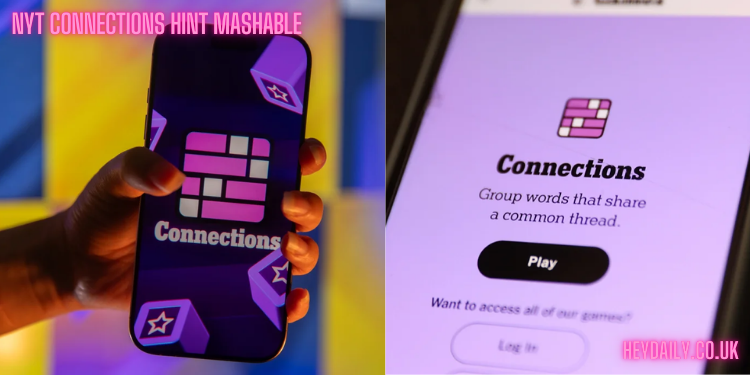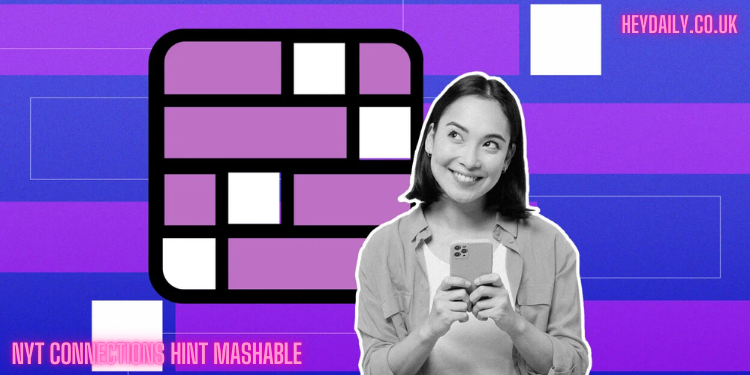The New York Times Connections puzzle is quickly becoming a daily ritual for word game enthusiasts. Designed to test not just vocabulary but cognitive flexibility, this intriguing game challenges players to group 16 seemingly unrelated words into four categories of four. While that sounds simple on the surface, the categories often hide in plain sight — built on slang, pop culture, or subtle conceptual links.
It’s the sort of puzzle that tickles the brain, encourages lateral thinking, and offers that delightful “aha” moment when a set clicks. However, as the difficulty ramps up across the color-coded groupings — yellow (easiest) to purple (most difficult) — many players look for a little help without ruining the fun. In this article we will what makes different for Nyt connections hint mashable and check how these hints are effective.
What Are NYT Connections Hints?
Hints serve as a nudge in the right direction for solvers who might be stuck or unsure of their groupings. These subtle suggestions don’t spoil the answers but instead aim to guide the user’s thought process. You may be told a general theme like “types of pasta” or “things that are twisted,” prompting your brain to search for related terms from the word bank.
The idea is not to give away the puzzle, but to illuminate a possible pathway, especially when words can fit more than one category — one of the trickiest and most brilliant elements of the game.
How Mashable Helps with Daily NYT Connections Hints
That’s where Mashable comes in. Known for its up-to-date digital culture coverage, Mashable now plays a daily role in helping NYT Connections fans get over the hump with carefully curated hints. Unlike spoiler-heavy sites or direct solution forums, Mashable maintains the challenge’s integrity by offering tiered support: hints, followed by categories, and only then the full answers — and only if you want them.
Each day, Mashable publishes a fresh article tailored to that day’s Connections puzzle. Readers will first see a thematic description of the categories — for example, “types of spreadsheets” or “helical objects” — with no direct word associations. This gives you the freedom to solve on your own terms but with just enough help if you’re close.
Today’s NYT Connections Hint Mashable
Let’s take April 21, 2025, as an example. Mashable categorized the hints in the following way:
- Yellow: Info on a nutrition label
- Green: Metaphor for something unexpected
- Blue: Things you can insert into a spreadsheet
- Purple: Helical things
These clues allow solvers to identify possible groupings without direct spoilers. From here, you might associate “protein” and “sodium” under nutrition labels, or spot “curveball” and “twist” as metaphorical surprises.
Mashable provides these hints while respecting the user’s solving experience. It’s one of the few platforms where puzzle lovers can stay challenged while getting subtle guidance.
Solving Strategies Inspired by Mashable’s Hints
To become better at solving NYT Connections, using hints the right way is key. Mashable often recommends starting with the easiest category — yellow — which typically includes words with the most obvious relationships. Once you’ve cleared the yellow group, you reduce the remaining variables, making it easier to detect the subtler connections in blue or purple.
Reading through Mashable’s hints can also sharpen your pattern recognition. You begin to notice repeated themes, linguistic tricks, or even cultural references the NYT tends to reuse. With each daily play and hint read, your mental library of categories grows stronger.
Common Themes and Categories Seen in NYT Connections
While the puzzle varies every day, there are recurring category types that solvers should be aware of:
- Pop Culture (TV shows, characters, slang)
- Culinary (types of pasta, kitchen tools)
- Science and Nature (elements, body parts)
- Abstract Concepts (emotions, movement types)
- Language (idioms, prefixes, suffixes)
- Tools and Objects (hardware, office supplies)
Mashable often uses real-world associations in their hints. For example, if a category is “types of charts,” Mashable may describe it as “ways to visualize data,” making your brain connect to terms like “bar” or “pie.”
What Makes Mashable’s Hints So Effective?
What sets Mashable apart is the human feel in their hints. They don’t use robotic descriptions or generic keyword-stuffed templates. Instead, you’ll find personality and a touch of humor. Their writers understand how to engage readers, not just provide answers.
The hints are designed to help you think rather than just win. This pedagogical approach makes it a learning tool as much as a cheat sheet. If you’re stuck, a Mashable hint might not tell you the answer outright — but it will shift your thinking just enough to get there on your own.

Alternative Sources vs. Mashable: Why Stick with Mashable?
There are other places online to get help with NYT Connections — Reddit threads, Discord puzzle groups, blogs — but none offer the structured, spoiler-free, and readable format that Mashable does. Other sources often reveal too much too soon, while Mashable breaks the content into hints, category labels, and finally, answers.
Additionally, Mashable updates early and consistently, providing reliability that many casual solvers appreciate. No ads breaking up the content, no scrolling through endless threads — just clear, daily help.
Tips for Becoming a Better NYT Connections Player
Aside from reading Mashable’s hints, there are a few habits that can make you sharper:
- Play daily – Like any skill, pattern recognition improves with repetition.
- Look for root meanings – Words with shared roots often indicate a group.
- Eliminate as you go – Even a wrong group gives you valuable info.
- Think laterally – Categories might be metaphorical, not literal.
- Engage with the puzzle community – Sharing thoughts helps you spot tricks you might have missed.
Mashable’s style supports these methods, encouraging users to explore different approaches rather than just rush to the finish.
Conclusion
If you enjoy the NYT Connections puzzle but sometimes get stuck, NYT Connections hint Mashable is a fantastic tool to enhance your experience without taking away the challenge. Their hints are crafted to guide, not spoil, offering just the right amount of help to keep the game fun, fair, and mentally rewarding.
So the next time you find yourself puzzled by a few leftover words, don’t be discouraged. Open Mashable’s daily guide, skim the hints, and you might just unlock the breakthrough you were looking for. Solving Connections isn’t just about knowledge — it’s about perspective. And Mashable helps shift that lens in a helpful, human way.
FAQs:
What time does Mashable post NYT Connections hints?
Mashable usually updates their hints early each day to align with the puzzle’s daily release schedule.
Do Mashable hints give away the full answers?
Not immediately. They offer hints first, category labels second, and full answers at the end — so you can stop wherever you want.
Are the hints beginner-friendly?
Yes, the hints are written clearly and meant to support all levels of players without making you feel overwhelmed or spoiled.
Can I still enjoy the game if I use hints?
Definitely. Many players use hints to learn and improve rather than skip the challenge entirely.
Is there a Connections archive on Mashable?
Yes, Mashable keeps an archive of past hints and answers, making it easy to look back and analyze previous puzzles.
Do visit for more: Heydaily.co.uk









